Age of Mythology Showcase: Isis
Our final showcase of the Egyptians examines the lone female god in Age of Mythology, Isis. Read on for more details.
Heading into the final leg of our Age of Mythology marathon, we have only two cultures left to showcase. This month we take a peek at the last Egyptian god: Isis. She is the lone female representative among the major gods of Age of Mythology and is perhaps the most versatile of the bunch.
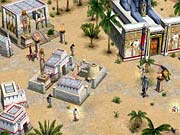
According to codesigner Greg Street, "Isis was one of the original Egyptian goddesses, the daughter of the earth and the sky. When her husband, Osiris, inherited the rulership of Egypt, Isis worked with him to bring culture to the Nile valley. She taught weaving and medicine to the people and introduced the concept of marriage." This history explains many of her positive and peaceful culture bonuses and her god power. "But," hastens Street, "Isis also had a sinister streak. She tricked Ra into revealing his secret name to her, which allowed Isis to steal some of his power. When Set tricked and killed Osiris, Isis kept her son, Horus, hidden in secret until he was strong enough to face, and defeat, the wicked Set."
Her background as the goddess of magic, protection, and fertility doesn't lend itself to any one dominating strategy, so instead, Street says, "we made her the most well-rounded of the major gods. While Hades has bonuses that benefit archers, and Odin likes to use hill fort units, Isis can pretty much specialize in any Egyptian strategy she sees fit."
To encourage her diverse style, Isis has several bonuses. The most prominent is cheaper improvements. Every single technology in the game, including age upgrades, costs the Isis player 10 percent less food, wood, and gold. As a result, an Isis player will get access to technologies faster than other gods, get the jump on age advancements, and have extra resources left over. Says Street, "Isis typically has more economic and military upgrades than other gods and is not afraid to abandon a unit line, switching from camels to slingers for instance." Street notes that the impact of this bonus seems biggest in the early game, but it retains its extreme usefulness well into the final age.
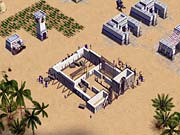
Isis' other great bonus is a defensive one, and it is perhaps the best defensive bonus in the game. Her monuments negate all god powers within a 50-meter radius. While creatures summoned by god powers and global god powers like rain and eclipse still work, god powers that target any area within the monument's radius of effect are completely disabled. Street notes, "The enemies' cursors are simply crossed out along with the notification that Isis is preventing god powers from being used in the area. This makes Isis' cities virtually immune to destructive effects such as meteors and pestilence." In order to affect an Isis town with such god powers, you have to first destroy the monument. This leads to massive strategic strikes on Isis' monuments, which would also cripple the Isis player's favor gathering. As a result, players who choose Isis will have to guard their monuments well, as they are the biggest targets in the game. Since Egyptians can have only five monuments on a map at a time, however, you will have to be strategic and smart about where you place such god power-thwarting structures--although you can delete a monument to build another if you so need or desire. This defense bonus makes Isis a popular choice to play, and it also makes the Isis player a highly coveted partner in team games, as you can protect both your settlements and your ally's settlements.
Isis' final bonus is a town center boost. Her town centers and citadels provide a +3 bonus to population. Says Street, "Assuming Isis builds three town centers on a map, she can have three to four more soldiers in a battle or many more villagers back home working."
Isis' God Powers
While Isis enjoys unmatched flexibility to charge ahead with any strategy as the need arises, one area in which she falls short compared to the other two Egyptian gods--Set and Ra--is scouting. Set can use his vision god power and command animals to scout for him, while Ra can afford to send his pharaoh out to scout because he has priests that can empower for him back at base. Isis, on the other hand, has no such ability. To make up for this, Isis' priests can construct obelisks faster and cheaper. In a normal game, the Isis player can thus scout the surrounding lands and lay down obelisks quickly for permanent vision around the map.
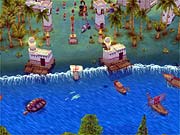
Rounding out Isis' abilities are her god power and myth technology. Her god power is prosperity, which gives you a huge gold bonus for a short time. Currently, the designers have it set at a +80 percent bonus lasting 50 seconds, although as with all numbers, this could change after more play testing. Street expounds on the god power, saying, "Unlike rain, prosperity only affects the player who uses it. Because they spend gold instead of wood on many buildings, Egyptians really appreciate getting in gold faster at crucial moments of the game." Isis' myth tech is called flood of the Nile and gives a steady trickle of food for the entire game, in similar fashion to Hades' Vault of Erebus. That extra food is good for additional units or as a commodity to barter in the new market and trade system.
The three cultures all share the same market building, albeit with different art. The market is built in the third age and is a prerequisite for entering the fourth (tribute is no longer tied to the market and is available from the beginning of the game). Once built, it allows you to buy and sell food and wood, but not favor. The market is also where you build caravans. While each culture has different art for their caravans, they all do the same thing. Street explains, "In Age of Mythology, trade routes are made between a market and a town center. The caravan collects gold from a town center and deposits it at a market. This change in the model has a few really cool benefits. First, it forces trade routes to be out in the open. A team cannot send their trade units on the very edge of the map, behind their towns, where they are unlikely to be attacked. Assuming you can locate enemy town centers, you can take out their trade route, which is often a really potent strategy to winning the game. Second, you can trade between your own market and town center, which makes caravan trade possible in player-vs.-player games or single-player scenarios. Like Age of Kings, the Age of Mythology trade formula has a linear and a much larger exponential component, which protects against very short trade routes being overly profitable." The market also has three improvements: ambassadors, which reduce the tribute penalty; tax collectors, which reduce the trading penalty at the market; and coinage, which increases profits from trade routes.
All of Isis' economic bonuses are great, but when the time comes for war, she is no slouch. Her bonuses ensure that she has resources to spare for a sizeable army, including expensive siege engines.
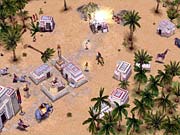
Speaking of siege weapons, Street says, "Unlike the Norse or Greeks, Egyptian siege weapons come from a dedicated building, the siege works. This building provides the siege tower in the Heroic Age and the mighty catapult in the Mythic Age, as well as the draft horses and engineer improvements. The siege tower is a potent engine of destruction equipped with a heavy battering ram. The siege tower can garrison infantry and archers, and, even when ungarrisoned, can fire arrows like a tower at enemy units. Once it reaches a building, the ram is deployed. The siege tower is more expensive and harder to kill than the Norse portable ram. It is weaker and less expensive than the Greek helepolis and lacks that unit's (small) range. The catapult is the most powerful ranged siege unit in the game--two to three times stronger and more expensive than the Greek petrobolos." Of the two siege technologies, draft horses increase the movement speed of siege weapons, while engineers increase siege weapon damage, especially against walls. Street explains, "While the Greeks and Norse tend to have weaker siege weapons in the Heroic Age, and powerful ones in the Mythic Age, the Egyptian siege weapons are both viable and useful throughout the game. Egyptians have several myth improvements which benefit siege weapons as well, especially through Sekhmet in the Heroic Age."
Minor Gods
The minor gods at Isis' beck and call give her considerable military power to compensate for her economic tendencies. It all goes back to ensuring that she has the most versatile strategies at her disposal. In the Classical Age, she can choose between Anubis and Bast. Bast is the cat-headed goddess of felines. Says Street, "Cats were sacred in ancient Egypt, largely because they prevented rats from eating all the grain. Much as the cats inadvertently protected food supplies, so did Bast take on the role of protector of humanity."
Bast's god power is the often-changed eclipse, which appears to have now reached its final iteration. Street reveals, "Eclipse has gone through more changes than virtually any other god power. Fans who saw early previews or participated in AOM alpha tests may remember that eclipse once lowered the range of ranged units for everyone on the map. Unfortunately, Egypt with her slingers, chariots, priests, and towers is pretty dependent on ranged units, and her allies get pretty annoyed when their own ranged units are rendered impotent. Eclipse, in its final form, increases the speed and attack of myth units while it lasts. We figured an eclipse was a major event in ancient times, and associated with magical or horrible events. Thus, the monsters roam wild. While eclipse is useful on Bast's sphinxes, it is often nice to save until later in the game, in case she has trained some of Osiris' mummies or Thoth's phoenixes. Eclipse is one of the longest-lasting god powers that prevents other god powers for its duration."

The myth unit opened up by worshipping Bast is the human-headed, lion-bodied sphinx. "Like eclipse," says Street, "the sphinx has undergone a great deal of iteration. At one point, the sphinx could teleport through walls, but that merely detracted from the coolness of the leaping anubite. Now the sphinx has a special attack to turn into a cyclone when attacking. Unlike the attack of Horus' avenger, this is not just attacking every unit around, but an actual miniature tornado. When the sphinx is in cyclone form, it cannot be attacked. Once the sphinx re-forms, it can then resume attacking with its claws. The sphinx has a few other properties that make it an interesting myth unit. Because of the lion's body, the sphinx is pretty fast at crossing the map. It is also potent against buildings, which makes it quite useful for a second-age myth unit." Bast offers two upgrades for the sphinx and two economic improvements. The criosphinx upgrade boosts the sphinx's hit points by 25 percent and increases damage by 20 percent. The hieracosphinx upgrade adds a further 20 percent increase in attack and movement speed. Street says the terms aren't from Dungeons & Dragons: "Despite the familiarity of these words from RPGs, they were originally coined by the Greek historian Herodotus, who made a distinction between the man-headed androsphinxes, the ram-headed criosphinxes, and the hawk-headed hieracosphinxes. Greek sphinxes, by contrast, were typically female gynosphinxes. In fact, the word 'sphinx' itself is Greek. The Egyptians called their creatures 'hu.'"

Bast's economic upgrades are sacred cats and adze of Wepwawet. The sacred cats improvement increases the production rate of farms (remember that the traditional role of cats in Egypt was to protect granaries from rats). Adze of Wepwawet, meanwhile, is named after the Egyptian god Wepwawet, who is associated with funerary rites. The adze was a planelike tool he used for shaving wood. Says Street, "In Age of Mythology, researching his adze allows Egyptian villagers to fell a tree in one shot, which greatly improves their ability to collect wood. Remember, even though they don't need wood for buildings, Egyptians do need wood for slingers, chariots, ships, and siege weapons, as well as many improvements."
Cows in the Third Age
In the Heroic (third) Age, Isis' choice is between Hathor and Nephthys. Nephthys, covered last month, is the goddess of night and the wife of Set. Hathor, in contrast, is a much lighter-hearted deity. She is, after all, a cow-headed, cavorting being.
Street relates, "Hathor, the 'sexy cow goddess' as the AOM artists put it, was another extremely important goddess in ancient Egypt. She was the goddess of beauty and love, festivals and dance. In some myths, Sekhmet [the lioness-headed goddess of war detailed in the Ra showcase] is just one destructive aspect of the multifaceted Hathor. In AOM, Hathor benefits buildings and economy. She is a useful choice for Isis or Ra when either seeks to improve their economy or defense in order to do more fighting in later ages."
Hathor's god power is silent but deadly. It is called locust swarm, and it summons a plague of locusts on enemy farms, wiping them out. Farms are already expensive to build in Age of Mythology (and in later ages, which solely rely upon them for food), and they have finally been automated so as not to go empty, so this god power in effect reintroduces a typical Age farming weakness to your rivals. It is potent indeed.
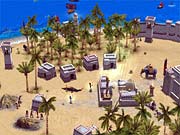
Unlike most gods, Hathor actually offers two myth units. One is the transporting roc, while the other is the glowing crocodilian petsuchos, which is an homage to the Egyptian crocodile god Sobek. Says Street, "The roc is a gigantic flying transport--the only one in the game. While transport god powers like underworld passage and shifting sands are great for transportation, they can only be used once. Every culture has naval transports, but there are many maps that don't have appropriate bodies of water. Rocs can always fly past enemy defenses, assuming they aren't shot down, and transport your soldiers where you would like. Rocs can carry 15 units. The petsuchos is based on the servants of the Egyptian crocodile god, Sobek. Like their god, these bejeweled crocodiles have a small sun over their heads that they can use to focus beams of sunlight and fire them over a long distance." The sun rays of the petsuchos have a range of about 20 meters, and they are very potent, doing lots of damage, and from far away, per hit. To balance the high attack, the petsuchos has a slow recharge rate. One of its greatest advantages is that its attack is not a projectile but a beam, meaning the petsuchos has perfect accuracy.
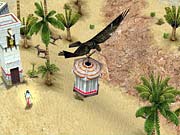
There are three mythical improvements offered by Hathor: crocodopolis, medjay, and sun-dried mud brick. Despite the names, these myth techs are very serious and beneficial. Street explains their benefits: "Crocodopolis (city of the crocodiles) upgrades your petsuchos by increasing their range by 4 meters (which is a lot when you consider how many more units can be targeted) and changes their name to the fearsome "petsuchos ra." Medjay is a nifty improvement that increases the life span of mercenaries. While mercenaries typically expire before they can do more than defend their town center, medjay mercenaries last for 30 seconds longer, which may allow them to actually go on the offensive. Medjays, incidentally, was the name for an Egyptian police force composed entirely of Nubians, much like the Age of Mythology mercenaries. Hathor also provides her main building benefit, sun-dried mud brick. This improvement not only increases building hit points by 20 percent, but it actually makes all Egyptian buildings that cost gold cost 15 percent less gold. Those 50-gold barracks start looking more appealing when they cost 42 gold."
The Walking Dead
Finally, we come to the Mythic Age. Here, Isis can choose between Osiris and Thoth. Street anticipates the questions and asks, "Why not her own son Horus? Well, Set needed to have two choices as well, and it made more sense for him to choose Horus than to choose his archenemy Osiris. Osiris came to rule the Egyptian pantheon after Ra became old and senile, and only after [Isis reassembled Osiris' body], which had been chopped into scattered bits by Set. If we wanted AOM to stick close to Egyptian mythology, we would even consider having Osiris replace Ra for the Age of Mythology expansion pack.
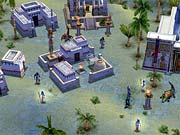
"Osiris' god power is the unusual Son of Osiris. This god power can only be cast on your pharaoh (or one of your pharaohs--see below) and turns him into a hawk-headed, lightning-wielding demigod. The lightning attack is what makes this unit really stand out, though he can also empower or heal like a normal pharaoh. The Son of Osiris fires blasts of chain lightning that arc from one opponent to the next, often dropping them in groups at a time. While his attack is titanic, his hit points are not, and he can be killed provided you can get through the lightning bolts. The Son of Osiris cannot be healed, and he can be bolted by Zeus, but unlike many of the god powers, he could keep blasting soldiers and myth units alike until the end of the game if he survives."
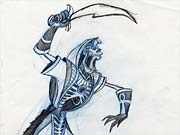
Osiris' mythological unit is the much-maligned mummy. Says Street, "Osiris was brought back from the dead, so it is fitting that his myth unit is the mummy. (Despite conventional wisdom, walking mummies were conceived by the Egyptians and were not made up by Hollywood.) The mummy is a ranged unit that hurls projectiles that resemble clouds of flies into combat. Not only do these flies cause damage, but they also have a chance to kill human soldiers [outright]. Those killed rise from the dead as minions to serve the mummy. The skeletal minions are under the player's control, but they can only sustain their presence for about 60 seconds before returning to dust."
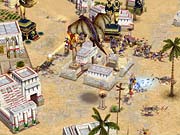
Osiris is a generous god with four mythological improvements. They are Atef crown, desert wind, funeral barge, and new kingdom. They are all quite powerful, especially new kingdom. Street elucidates, "Atef crown is a mummy upgrade that boosts mummy hit points by 20 percent, damage by 40 percent, and doubles the life span of minions. Desert wind is an incredible boost to camels, making them almost as strong as any Greek cavalry by increasing their speed, hit points, and attack all by 20 percent. Funeral barge is an improvement for the Egyptian kebenit (their archer ship) that lets them do double damage against other archer ships (including Greek triremes and Norse longboats), which somewhat negates the need for siege ships. Osiris' most interesting myth improvement is new kingdom, which grants a second pharaoh. Just like the original pharaoh, the additional pharaoh respawns if killed, so you will have two pharaohs for the rest of the game. They even have different names, so you can tell them apart. Having two pharaohs is an enormous benefit. You can defeat whole armies of myth units. You can empower two different buildings or two different cities at once. You can convert one pharaoh to a Son of Osiris and send him off to fight, while still keeping a pharaoh at home to empower buildings."
Clearly, Isis, especially with the help of her husband and the other minor gods, is a powerful adversary and a worthy god to pick when you play the game. On that note, we close out the Egyptian pantheon and turn one final time to the Norse. The last of nine gods is Loki, the trickster god, and he is an interesting one. Perhaps more than any other major god, he favors myth units. And we will see why next month.
Got a news tip or want to contact us directly? Email news@gamespot.com
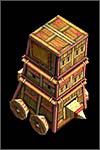
Join the conversation